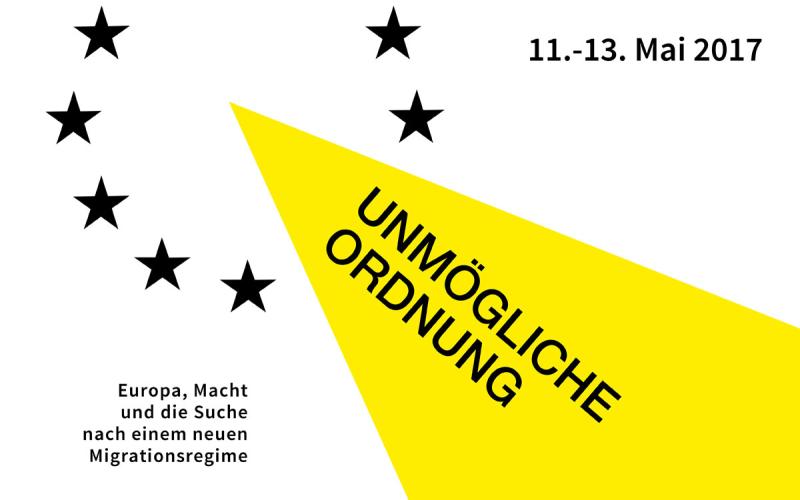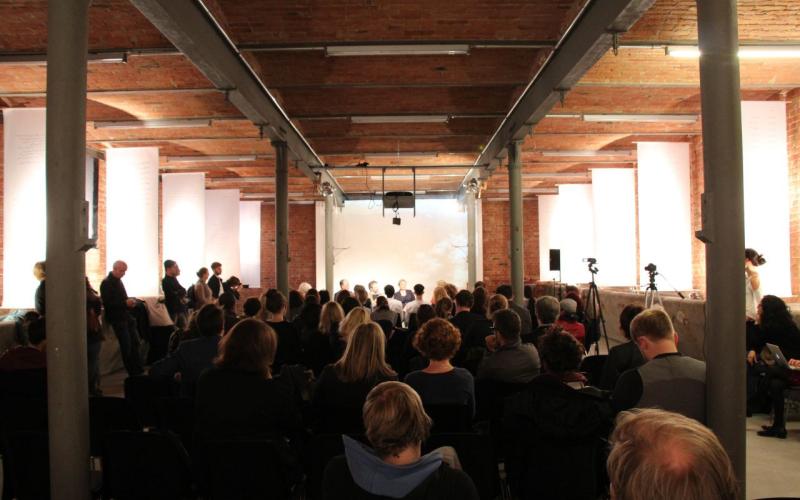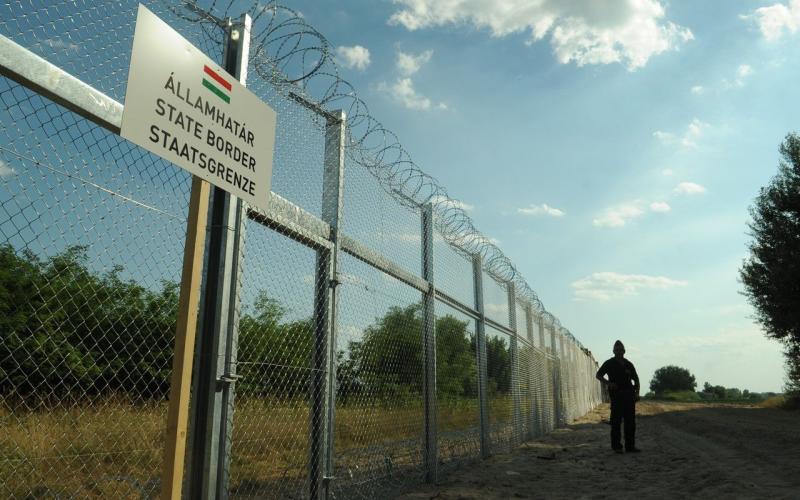Abstract: The main presenters of Panel VI (Migration, Education, Creativity) were the students of Bard College Berlin, who in conjunction with the Vienna Academy of Fine Arts created an exhibition of individual and group art projects devoted to migration and integration from academic and imaginative perspectives. These projects were displayed at the Berlin Wall Memorial Visitor Center throughout the duration of the conference and addressed themes including collective memories, stereotypes, weaknesses in the concept of integration, and both the crossing and the reproduction of various types of borders. Respondents Dr. Jane O. Newman and Dr. Mena Mark Hanna commented on the students’ efforts to offer an opportunity for intergenerational, “elliptical” dialogue that not only revealed the tragic nature of many migrants’ experiences, but also the potential these experiences hold for healing and rebirth. All of the panel participants reinforced the value of a liberal arts education in providing a space for the critical exchange of ideas and bridging the gap between the “academic” and the “everyday.”
Panel VI (Migration, Education, Creativity) brought a breath of fresh air to the conference as it principally consisted of young migration researchers rather than advanced academics or artists. The main presenters were eleven Bard College Berlin students and a representative of the Vienna Academy of Fine Arts. Additionally, the panel included Chair Kerry Bystrom (Bard College Berlin), Marion Detjen (ZZF Potsdam), who advised the students through their last two terms, and two external respondents, namely Jane O. Newman (University of California Irvine, American Academy of Berlin) and Mena Mark Hanna (Barenboim Said Academy, Berlin).
To open the panel, Kerry Bystrom introduced Bard College Berlin’s mission and values: Bard is an interdisciplinary liberal arts college that accommodates students of 54 nationalities, including newly arrived students from Syria and other countries. The Program for International Education and Social Change at Bard College Berlin was established as a reaction to the 2015 “refugee crisis.” During this time, Bard College asked itself what education means to society in the context of flight and global migration and how the institution could contribute to improving refugees’ access to higher education. This program, spearheaded by Dr. Marion Detjen, provides its students a space to approach the topics of migration and education in creative, innovative ways.
In conjunction with students from the Institute of Art and Architecture at the Vienna Academy of Fine Arts, the students of Bard College created an exhibition that blended artistic and academic approaches to migration and integration phenomena. The exhibition was on display at the Berlin Wall Memorial Visitor Center throughout the duration of the conference, and in Panel VI the artists had the chance to discuss their works with the audience and reflect on their own creative processes. In doing so they emphasized the subjective and ever-evolving character of their works in contrast to socio-political labelling practices that often refer to migrants and migration experiences in static, generalized terms. Through their art the students claim and enact a critical, vivid and sensual approach to education, one that engages hands-on with contradictions, controversial discussions and border crossings.
Brief summary of the exhibition pieces:
1) The presentations began with an Arabic poem. Although many conference participants put on their headphones to hear the German or English translation, by listening to the student speak aloud in her native language, one was able to achieve a better sense of her emotions.
2) Afterwards a student from the United States presented her project on the “Feast of the Passover” in relation to the question: How can memory be universalized? She decided to celebrate the “Feast of the Passover” together with her class. In this space participants could experience the Torah sensually without having read it.
3) The next project was also about “experiencing space”; however, the intention was not to create a common memory, but rather to open up space for diverse memories, perceptions and needs. The group responsible for this project investigated how female migrants from the “Global South” perceived the limitations and values of public spaces, as well as their own access to rights within these spaces. The students represented their findings in a series of drawings in which the viewer was invited to look through the eyes of the female migrants at their micro-universes. The group sought to highlight the agency of these women as they cope with borders and rejections, including, for example, the psychological and corporal consequences of refugee camps.
4) Taking the audience from the visual to the auditory sense, the following group presented their perceptions of the music they experienced during their flight from Syria to and through Europe. They realized that there were many instruments and musical styles they knew from their country of birth that they encountered again and again throughout their journeys. There is no music, no emotion, and no memory restricted to just one ethnic group. Music, like the migrants themselves, overcomes borders and connects spaces commonly perceived to be distinct from one another.
5) The fifth group considered two questions that had been common themes of the conference: What do we mean when we label someone a “refugee,” and how is “integration” defined over time? “Positive” interpretations of the terms were deconstructed to show that integration as it is commonly understood means more or less the same as “assimilation.” The team suggested that - like in the academic system - there should be more discussion in schools about definitions and perceptions of these problematic terms. The classroom should act as a “social sculptor” moulding an ever-evolving product through on-going negotiations.
6) But how should we negotiate when we cannot understand one other? The sixth presenter sought to find a pluralistic and inclusive mode of communication that overcomes perceived “cultural” and linguistic differences or, as she stated, the “gap of perceptions and memories.” To explore how humans can come together, regardless of their socioeconomic status and their ethnic or geographic “origins,” she filmed a trip on the Berlin metro from “Sonnenallee to Niederschönhausen.” These two social spaces are often considered distinct from one another, but this project shows that they are, in fact, connected. Through music and landscape, the viewers take part in a universal activity and experience how humans can feel “understanding” across social boundaries on an emotional level.
7) The seventh project led the participants into new spheres of border crossings. The student first collected anti-Jewish stereotypes. Then the labelling of refugees in Europe caught her attention. Upon examining memes containing these racist messages, she wanted to react directly to them. In order to do so, she re-designed these memes, transforming them into something humorous. Harnessing the spirit of an inclusive liberal arts education, conference participants were invited to take part in this act of resistance by adding something of their own to the artwork. The memes presented a refreshing method to deconstruct borders and transform negative stereotypes through irony and humor.
8) Similarly, the next project examined “integration courses” and the “right way” to achieve “successful integration.” The students engaged the audience with questions such as: Do you like to eat asparagus or not? Have you remembered to do your grocery shopping before the stores close on Sunday? This exercise was not only entertaining, but also made it ironically clear that integration involves much more than passing an integration test. For further reflections on the discrepancy between emotional and legal integration, audience members were invited to read the students’ blog.
9) The next presentation was about the projects themselves – how to reconstruct, group and display the artworks in a way that captured their dynamic character. An architecture student from the Vienna Academy of Fine Arts detailed the challenges and rewards of working with the Bard students to design the exhibition. A stop-motion video showed the construction of the exhibition and transformed the supposedly unmoving projects, including the walls and partitions, into moving ones. The video further accentuated the great engagement of the students from Bard and Vienna in realizing their visions in every detail of the exhibition.
10) The final Bard College student in the panel concluded the vivid presentations in a reflection on the importance of a well-rounded and critical education system. Through her friend Frederick, a potted plant that served as a metaphor for a liberal arts education, the student argued that we should nurture this kind of instruction with continuous care. Although she initially did not plan on speaking to the audience, her comments provided the perfect conclusion to the multi-faceted student presentations.
For respondent Jane O. Newman the students’ projects exemplified her concept of elliptical thinking. An ellipse is balanced by two points that are in constant conversation with one another. The cooperation between Bard College and the Vienna Academy of Fine Arts presents one example of such elliptical dialogue, in addition to the connections between postwar German migration and contemporary migration movements explored in the students’ work and the intergenerational exchanges that took place during the conference. The benefits of elliptical thinking include moving us out of our comfort zones, keeping intellectual positions from becoming static, and preventing us from thinking about “one-size-fits-all” solutions to perceived social problems.
Mena Mark Hanna presented a similar commentary from a musicologist perspective. Using examples from 20th century composers like Arnold Schönberg and Karlheinz Stockhausen, artists who combined human voices with electronic waves, Hanna introduced the concept of dissonance connected to exile or banishment. Referencing Edward Said, Hanna discussed the term “counterpoint” as an interaction between one’s past and one’s current life, another form of elliptical thinking. For Hanna, this process, embodied in the students’ projects, is not merely a tragic one, but also one of creation and rebirth.
The audience was in awe of the students’ work and the reflections they shared during their presentations. Bard College’s approach seemed to provide an answer to the recurring question throughout the conference: How do we make insights gleaned from academic studies accessible in daily life? A liberal arts education that brings students from various backgrounds together and provides them the space and the freedom to interact with one another and the external environment is one possible bridge between the “academic” and the “everyday.” For this reason, as one student eloquently expressed, it is our responsibility to foster this type of education.
Zitation
Stefanie Hamm, Kaitlyn Kennedy, Hannah Niedenführ, Migration, Education, Creativity. Panel VI , in: Zeitgeschichte-online, , URL: https://zeitgeschichte-online.de/themen/migration-education-creativity



